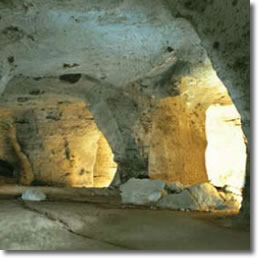
- Piperno cave at the Masseria del Monte
The block rocks of the Phlegraean Fields
The built-up patrimony of the Phlegraean Fields dating from Greek and Roman times consists mainly of block-type rocks, like gravestones which cropped out in the Phlegraean caldera and in the immediately surrounding srea. The road surfaces were laid in grey lava stone (Arco Felice Vecchio and the Via Sacra to Cuma). Other linkways used for trading and military purposes (The Cave of Pozzuoli, the Cave of Seiano, the Cocceio Viaduct) were dug out by the Romans in the Neapolitan Yellow Tufo and in the Yellow Tufo that crops out in the Phlegraean caldera. The use first by the Greeks and then by the Romans of Grey Campania Tufo, a rock that rapidly deteriorates by the action of exterior agents, was somewhat limited. One of the main reasons for the inhabitants digging into the subsoil was that these rocks are easily dug out, and above all easy to work. Also, the need to obtain building materials from the subsoil was imposed by the increasing urban expansion of the city.
Another reason for the presence of a cavea network in the suboil of Naples is that the city is built exclusively on volcanic ground and therefore lacked a basic natural resource: water, with the exception of that of the River Sebeto. For this reason, the creation of the Claudio Aqueduct (1st century AD) and the Carmignano Aqueduct (17th century) was indispensible. The Claudio Aqueduct carried the waters of the Serino through a network (about 90 kilometres) of underground passages dug out of the tufaceous rock and the water was from time to time collected in cisterns until it ended up in the Piscina Mirabilis of Bacoli, a reservoir.
Most of these works in the underground environment were created by digging into the Yellow Neapolitan Tufo; its width, often more than one hundred metres, constitutes the basic framework of Naples. For this reason, the whole cavea network recorded by the Ufficio Sicurezza geologica e Sottosuolo of the Commune of Naples (the department responsible for geological and subsoil security) extends throughout the whole volcanic area.